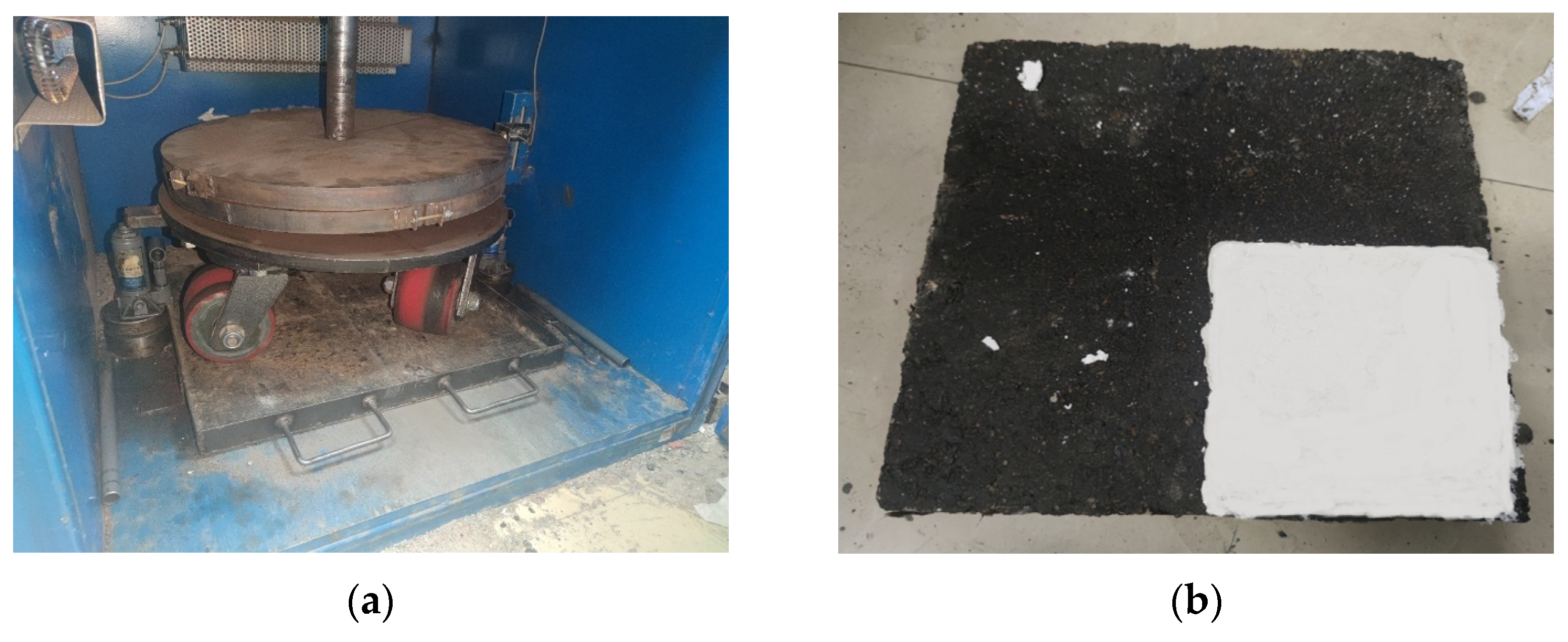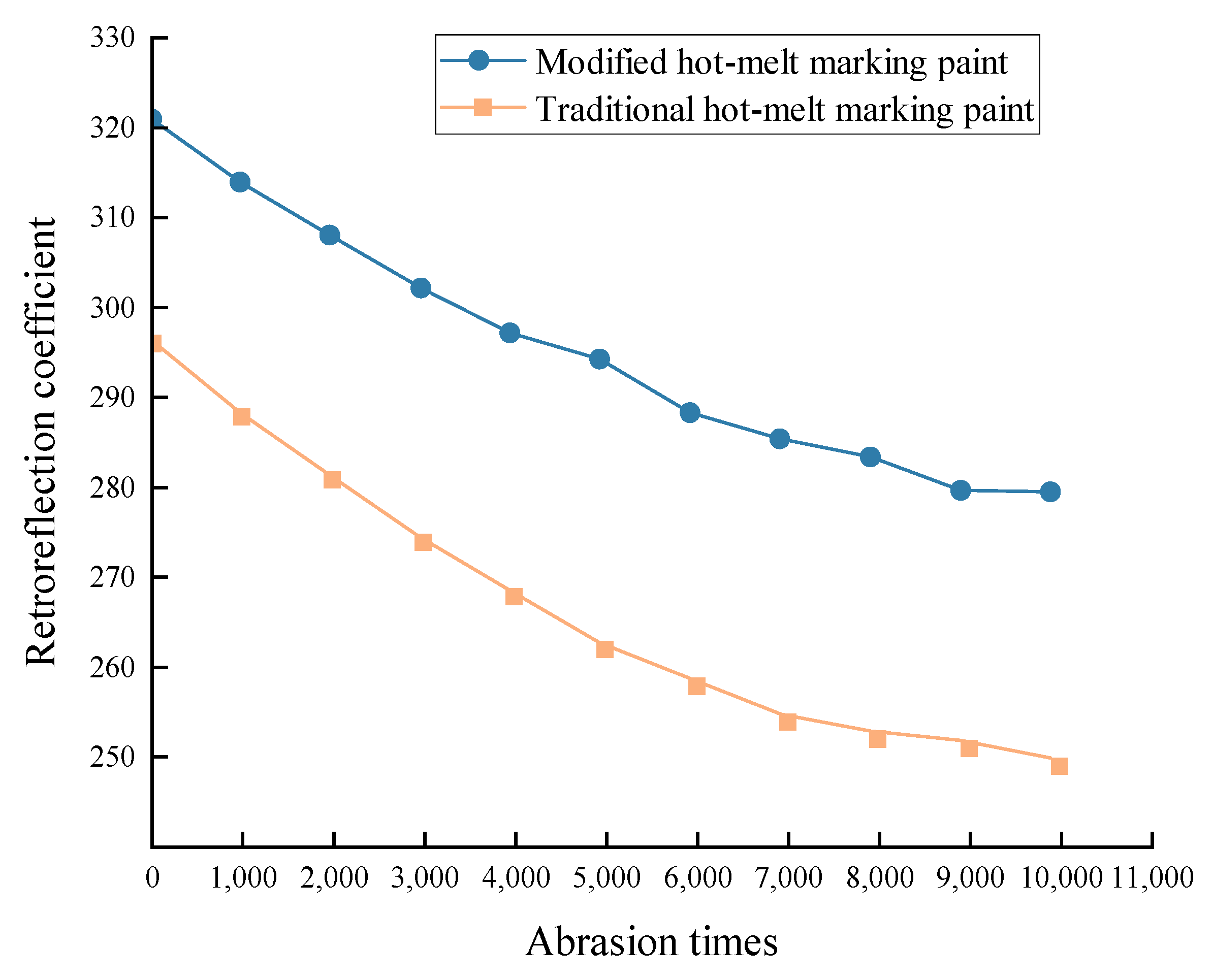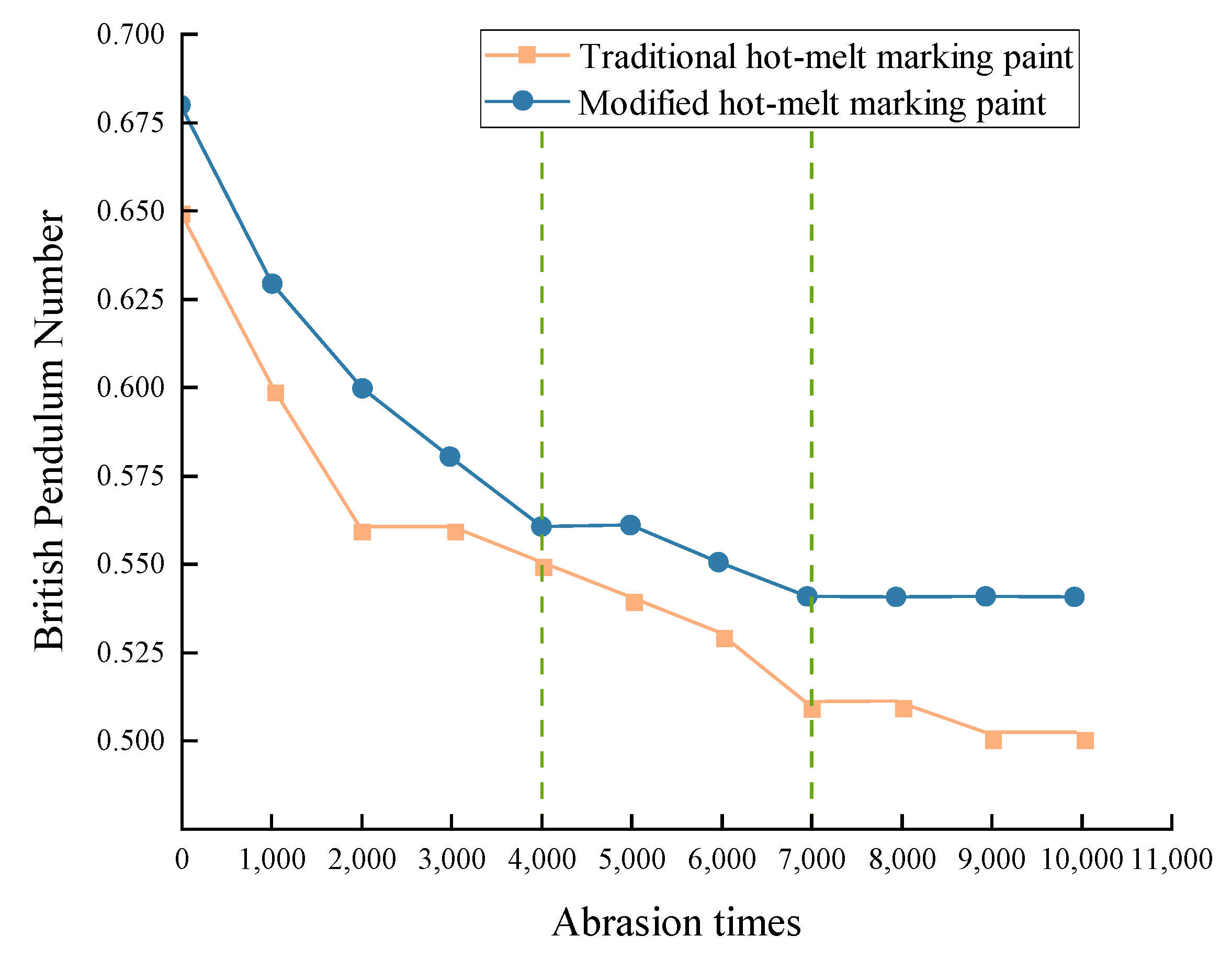Study on the Reflective Principle and Long-Term Skid Resistance of a Sustainable Hydrophobic Hot-Melt Marking Paint
Abstract
:1. Introduction
2. Methodology
2.1. Materials
2.2. Preparation Methods
2.3. Accelerated Wear Test
2.4. Retroreflective Coefficient Test
2.5. Long-Term Skid Resistance Test
3. Results and Discussions
3.1. Retroreflective Properties of Hydrophobic Hot-Melt Marking Paint
3.2. Long-Term Skid Resistance of Hydrophobic Hot-Melt Marking Paint
3.3. Construction and Maintenance Methods
4. Conclusions
- (1)
- Polytetrafluoroethylene was used as the hydrophobic polymer material to modify the road marking paint. PTFE has good hydrophobic properties, as well as excellent thermal stability and aging resistance. After using PTFE as a polymer material to modify the marking paint, the durability and reflective performance of the marking paint is improved.
- (2)
- The skid resistance performance and retroreflective performance of the marking paints were measured by accelerated abrasion test to simulate the abrasive effect of road vehicles on the marking. The results show that the friction factor of the modified marking paint is 4.62% higher than that of the traditional hot melt marking paint. And the friction factor of the modified coating is always higher than that of the traditional coating in the process of gradually increasing the amount of wear, and the skid resistance performance is improved.
- (3)
- In the test of the retroreflection coefficient, the initial values of the retroreflection coefficient of both marking paints meet the specification requirements, and the value of the retroreflection coefficient gradually decreases with the increase in abrasion times. By comparing the retroreflection brightness coefficients of the two coatings, the retroreflection performance of the marking paint with 4% hydrophobic material is more excellent. And the initial value of the retroreflection coefficient is increased by 8.45% compared with the traditional hot melt marking paint.
Author Contributions
Funding
Institutional Review Board Statement
Informed Consent Statement
Data Availability Statement
Conflicts of Interest
References
- Yang, Z.; Junjiang, T.; Zhan, H.; Jian, W. The Progress in Traffic Coatings. J. Guangdong Univ. Petrochem. Technol. 2014, 24, 4–7. [Google Scholar]
- Rehman, S.A.U.; Duggal, A. Suitability of Different Materials Used for Road Marking: A Review. Int. Res. J. Eng. Technol. 2015, 2, 622–625. [Google Scholar]
- Carnaby, B. Poor road markings contribute to crash rates. In Proceedings of the 2005 Australasian Road Safety Research Policing Education Conference, Wellington, New Zealand, 14–16 November 2005; p. 16. [Google Scholar]
- Editorial Department of China Journal of Highway and Transport. Review on China’s Traffic Engineering Research Progress: 2016. China J. Highw. Transp. 2016, 29, 1–161. [Google Scholar]
- Zhongnan, M. Analysis of Pollution Resistance of Road Markings. Highw. Transp. Technol. Appl. Technol. Ed. 2013, 9, 255–256. [Google Scholar]
- Nance, J.; Sparks, T.D. From streetlights to phosphors: A review on the visibility of roadway markings. Prog. Org. Coat. 2020, 148, 105749. [Google Scholar] [CrossRef]
- Jingjie, M.; Lei, H. Road Traffic Marking Visibility Study. China Stand. 2018, 20, 169–173. [Google Scholar]
- Xiaoyan, H.; Zhongyin, G.; Cancan, S.; Bencheng, Z. Safety Maintenance of Highway Traffic Sign and Pavement Marking Based on Visibility Attenuation. Highway 2019, 64, 271–277. [Google Scholar]
- Babić, D.; Fiolić, M.; Babić, D.; Gates, T. Road markings and their impact on driver behaviour and road safety: A systematic review of current findings. J. Adv. Transp. 2020, 2020, 7843743. [Google Scholar] [CrossRef]
- Carlson, P.; Park, E.S.; Kang, D.H. Investigation of Longitudinal Pavement Marking Retroreflectivity and Safety. Transp. Res. Rec. 2013, 2337, 59–66. [Google Scholar] [CrossRef]
- Diamandouros, K.; Gatscha, M. Rainvision: The impact of road markings on driver behaviour–wet night visibility. Transp. Res. Procedia 2016, 14, 4344–4353. [Google Scholar] [CrossRef] [Green Version]
- Zhu, J.; Tan, S. Construction Quality Control of Road Hot-melt Marking. Transpoworld 2018, 35, 24–26. [Google Scholar]
- Yanbo, Y. Hot melt type traffic marking quality factors and control points. Road Traffic Technol. Appl. Technol. Ed. 2020, 16, 75–78+103. [Google Scholar]
- Chen, M. Development and application of high-performance thermal melting rainy night marking. Fujian Transp. Technol. 2021, 11, 83–87. [Google Scholar]
- Taheri, M.; Jahanfar, M.; Ogino, K. Self-cleaning traffic marking paint. Surf. Interfaces 2017, 9, 13–20. [Google Scholar] [CrossRef]
- Yang, C.; Wu, Q.; Zhong, L.; Lyu, C.; He, G.; Yang, C.; Li, X.; Huang, X.; Hu, N.; Chen, M.; et al. Liquid-like polymer-based self-cleaning coating for effective prevention of liquid foods contaminations. J. Colloid Interface Sci. 2021, 589, 327–335. [Google Scholar] [CrossRef]
- Jiang, W.; Zong, X.; Wang, X.; Sun, Z. Transparent Coating with TiO2 Nanorods for High-performance Photocatalytic Self-cleaning and Environmental Remediation. Chem. Res. Chin. Univ. 2020, 36, 1097–1101. [Google Scholar] [CrossRef]
- Liu, J.; Shen, L.; Du, S.; Feng, G.; Dai, L.; Xue, J.; Shu, X. A Self-Cleaning Two-Component Road Marking Paint and Preparation Method Thereof. Patent CN102775872A, 14 November 2012. [Google Scholar]
- Mirabedini, S.M.; Jamali, S.S.; Haghayegh, M.; Sharifi, M.; Mirabedini, A.S.; Hashemi-Nasab, R. Application of mixture experimental design to optimize formulation and performance of thermoplastic road markings. Prog. Org. Coat. 2012, 75, 549–559. [Google Scholar] [CrossRef]
- Gao, K.; Gao, E. Analysis of the Development Direction of Road Marking Materials from Economic Benefit. China Build. Mater. Technol. 2020, 29, 47–49. [Google Scholar]
- Feng, S.; Zhong, Z.; Wang, Y.; Xing, W.; Drioli, E. Progress and perspectives in PTFE membrane: Preparation, modification, and applications. J. Membr. Sci. 2018, 549, 332–349. [Google Scholar] [CrossRef]
- Dhanumalayan, E.; Joshi, G.M. Performance properties and applications of polytetrafluoroethylene (PTFE)—A review. Adv. Compos. Hybrid Mater. 2018, 1, 247–268. [Google Scholar] [CrossRef]
- Wenzel, K.M.; Burghardt, T.E.; Pashkevich, A.; Buckermann, W.A. Glass beads for road markings: Surface damage and retroreflection decay study. Appl. Sci. 2022, 12, 2258. [Google Scholar] [CrossRef]
- Jafari, P.; Sabbagh Alvani, A.A.; Sameie, H.; Salimi, R. To what extent glass beads are important in road markings. Adv. Mater. New Coat. 2021, 10, 2748–2756. [Google Scholar]
- Zheng, J.; Du, L. The Reasonable Application of the Light-Reflection Principle of Road Mark and Glass Ball. Shanxi Sci. Technol. Commun. 2004, 5, 75–77. [Google Scholar]
- Zwahlen, H.T.; Schnell, T. Visibility of road markings as a function of age, retroreflectivity under low-beam and high-beam illumination at night. Transp. Res. Rec. 1999, 1692, 152–163. [Google Scholar] [CrossRef]
- Leng, Z.; Wang, L.; He, H.; Wang, R. Simulation analysis of reflective performance of marking glass beads. J. Phys. Conf. Ser. 2021, 1952, 042004. [Google Scholar] [CrossRef]
- Qi, X.; Guan, L.; Zhang, C. The Analysis of the Influencing Factors for Pavement Marking Reflective Performance. Shanxi Sci. Technol. Commun. 2014, 5, 93–95+103. [Google Scholar]
- Feng, L. To Improve the Inverse Reflection Iuminance Coefficient of Hot Melt Traffic Line Marking. Commun. Sci. Technol. Heilongjiang 2021, 44, 167–168+172. [Google Scholar]
- Ivanov, L.; Kiesewetter, D.V.; Kiselev, N.; Malyugin, V.I.; Slugin, V. Measurement of retroreflection by glass beads for road marking. In Proceedings of the Lasers for Measurements and Information Transfer 2005, St. Petersburg, Russian, 8–10 June 2005; pp. 249–258. [Google Scholar]
- Babic, D.; Fiolic, M.; Prusa, P. Evaluation of road markings retoreflection measuring methods. Eur. Sci. J. 2014. [CrossRef]
- JTG E20-2011; Application Handbook of Standard Test Methods of Bitumen and Bituminous Mixture. China Communications Press: Beijing, China, 2011.
- Yi, M. Discussion on Construction Technology and Quality Control of Hot-melt Road Marking. Shanxi Archit. 2011, 37, 138–139. [Google Scholar]
- Bi, Y.; Pei, J.; Chen, Z.; Zhang, L.; Li, R.; Hu, D. Preparation and characterization of luminescent road-marking paint. Int. J. Pavement Res. Technol. 2021, 14, 252–258. [Google Scholar] [CrossRef]
- Hao, X. Exploration on construction technology of expressway hot-melt marking. China Highw. 2017, 5, 90–91. [Google Scholar]
- Kang, B.; Kang, S. Trend in glass bead and regulation of road marking, and suggestions for preparing an autonomous vehicle age. J. Korean Cryst. Growth Cryst. Technol. 2019, 29, 229–237. [Google Scholar]





| Test Items | Unit | Technical Requirements | Test Results |
|---|---|---|---|
| Mass fraction of water-soluble matter | % | ≤0.6 | 0.453 ± 0.009 |
| Mass fraction of volatiles at 105 °C | % | ≤0.5 | 0.372 ± 0.007 |
| Mass fraction of TiO2 | % | ≥90 | 93.7 ± 0.4 |
| Mass fraction of sieve residue | % | ≤0.1 | 0.046 ± 0.002 |
| Performance Index | Test Method | Unit | Test Results |
|---|---|---|---|
| Viscosity | ATM D3236 | cPs | 27.3 ± 0.3 |
| Density | ATM D1505 | g/cm3 | 0.94 ± 0.04 |
| Softening point | ATM D3954 | °C | 116 ± 1 |
| Whiteness index | ATM E313 | - | 65 ± 0.5 |
| Test Items | Technical Indicators | Test Results |
|---|---|---|
| Rounding rate | ≥80% | 87 ± 0.8 |
| Refractive index | Ri ≥ 1.90 | >1.9 |
| Particle size distribution | 0 (S > 6000) | 0 |
| 50~90 (300 < S ≤ 600) | 73.56 ± 0.09 | |
| 5~50 (150 < S ≤ 300) | 24.60 ± 0.06 | |
| 0~5 (S ≤ 150) | 1.84 ± 0.02 |
| Product Properties | PTFE-090 | |
|---|---|---|
| Appearance | White slightly powdery | |
| Particle size | Dv50 | 5~9 |
| Dv90 | 25 ± 1 | |
| Melting point | 3200 ± 2 | |
| Test Methods | Advantages | Disadvantages | Evaluation Indicators | |
|---|---|---|---|---|
| Contact measurement methods | Sand laying method | Easy and fast operation | Fixed-point measurement, subject to human subjective influence | Depth of construction |
| Pendulum method | Easy to operate | British pendulum value (BPN) | ||
| Drainage method | Suitable for porous and rainy anti-skid roads | Fixed-point measurement, influenced by environmental humidity | Depth of construction | |
| Non-contact measurement methods | Trailer tribometer method | Continuous measurement, high efficiency | High equipment price | Friction factor |
| Laser measurement method | High precision and fast | Texture parameters such as tectonic depth | ||
| Industrial CT scan | High precision | Texture 3D digital information | ||
Disclaimer/Publisher’s Note: The statements, opinions and data contained in all publications are solely those of the individual author(s) and contributor(s) and not of MDPI and/or the editor(s). MDPI and/or the editor(s) disclaim responsibility for any injury to people or property resulting from any ideas, methods, instructions or products referred to in the content. |
© 2023 by the authors. Licensee MDPI, Basel, Switzerland. This article is an open access article distributed under the terms and conditions of the Creative Commons Attribution (CC BY) license (https://creativecommons.org/licenses/by/4.0/).
Share and Cite
Chen, J.; Li, R.; Zhang, Y.; Wu, Y.; He, H. Study on the Reflective Principle and Long-Term Skid Resistance of a Sustainable Hydrophobic Hot-Melt Marking Paint. Sustainability 2023, 15, 9950. https://doi.org/10.3390/su15139950
Chen J, Li R, Zhang Y, Wu Y, He H. Study on the Reflective Principle and Long-Term Skid Resistance of a Sustainable Hydrophobic Hot-Melt Marking Paint. Sustainability. 2023; 15(13):9950. https://doi.org/10.3390/su15139950
Chicago/Turabian StyleChen, Jun, Rui Li, Yang Zhang, Yi Wu, and Haiqi He. 2023. "Study on the Reflective Principle and Long-Term Skid Resistance of a Sustainable Hydrophobic Hot-Melt Marking Paint" Sustainability 15, no. 13: 9950. https://doi.org/10.3390/su15139950





